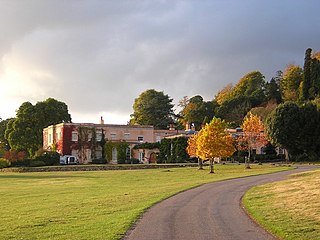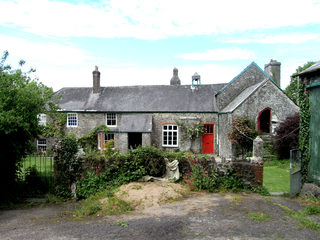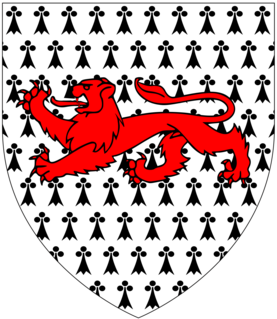
Beaford is a village and civil parish in the Torridge district of Devon, England. The village is about five miles south-east of Great Torrington, on the A3124 road towards Exeter. According to the 2001 census the parish had a population of 393, compared to 428 in 1901. The western boundary of the parish is formed by the River Torridge and it is surrounded, clockwise from the north, by the parishes of St Giles in the Wood, Roborough, Ashreigney, Dolton, Merton and Little Torrington.

Trerice is an historic manor in the parish of Newlyn East, near Newquay, Cornwall, United Kingdom. The surviving Tudor manor house known as Trerice House is located at Kestle Mill, three miles east of Newquay. The house with its surrounding garden has been owned by the National Trust since 1953 and is open to the public. The garden features an orchard with old varieties of fruit trees.

Killerton is an 18th-century house in Broadclyst, Exeter, Devon, England, which, with its hillside garden and estate, has been owned by the National Trust since 1944 and is open to the public. The National Trust displays the house as a comfortable home. On display in the house is a collection of 18th- to 20th-century costumes, originally known as the Paulise de Bush collection, shown in period rooms.

Colonel John Dyke Acland, of Tetton and Pixton in Somerset, was Tory Member of Parliament for Callington in Cornwall and fought in the American War of Independence in 1776.

Goodleigh is a village, civil parish and former manor in North Devon, England. The village lies about 2 1⁄2 miles (4 km) north-east of the historic centre of Barnstaple. Apart from one adjunct at the south, it is generally a linear settlement.

Sir John Acland, 1st Baronet of Acland in the parish of Landkey and of Columb John in Devon, England, was a Royalist commander in the Civil War, during the early part of which he maintained a garrison for the king on his estate of Columb John. He was created a baronet in 1644 for his support, but the letters patent were lost or never finalised and the dignity was not confirmed until 1677/8, long after his death. He compounded with Parliament for his estate in 1646 and died the following year.

Sir Thomas Dyke Acland, 7th Baronet of Killerton in Devon and Petherton Park in Somerset, was Member of Parliament for Devon, 1746–1747, for Somerset, 1767–1768, and was High Sheriff of Somerset in 1751. He was a prominent member of the West Country gentry, and a famous staghunter who used as his hunting seats his wife's Exmoor estates of Pixton and Holnicote.

Sir Thomas Dyke Acland, 9th Baronet of Killerton in Devon and Holnicote in Somerset, was a prominent landowner and member of the West Country gentry. He was especially noted for his passion for staghunting, in which respect he took after his father. Like his father he was known locally in Devon and Somerset as "Sir Thomas his Honour".

Sir John Acland of Columb John in the parish of Broadclyst, Devon, was an English knight, landowner, philanthropist, Member of Parliament and Sheriff of Devon. He was one of John Prince's Worthies of Devon.

Sir Arthur Acland (1573–1610) of Acland in the parish of Landkey, Devon, was a member of the Devonshire gentry, and was knighted in 1606. Little is known of his life and career, but his monumental inscription survives above his impressive monument in Landkey Church. His son was Sir John Acland, 1st Baronet. He was ancestor to the prominent, wealthy and long-enduring Acland family of Killerton, which survives today in the direct male line.

The estate of Acland in the parish of Landkey, near Barnstaple in North Devon, England, was from 1155 the earliest known seat of the influential and wealthy family of Acland, to which it gave the surname de Acland. It is situated about 3/4 mile north-east of the village of Landkey, from which it is now cut off by the busy A361 North Devon Link Road.

Tetton is an historic estate in the parish of Kingston St Mary in the English county of Somerset. The present grade II* listed Tetton House dates from 1790 and was enlarged and mainly rebuilt in 1924-6 by Hon. Mervyn Herbert (1882-1929) to the design of the architect Harry Stuart Goodhart-Rendel.

Richard II Acland (1679–1729), lord of the manor of Fremington, near Barnstaple in North Devon, was a Member of Parliament for Barnstaple 1708–13. Following his marriage in 1700 to a wealthy heiress he built the large and grand Queen Anne style mansion house known as Fremington House, which survives with 19th century alterations. His arms are displayed on the parapet of Queen Anne's Walk in Barnstaple, as one of about twelve such arms representing members of the Corporation of Barnstaple who financed the building, completed in 1713, now grade I listed, originally called the "Mercantile Exchange", on Barnstaple Quay.

Sharpham is an historic estate in the parish of Ashprington, Devon. The Georgian mansion house, known as Sharpham House, overlooks the River Dart and is a Grade I listed building. The house was commenced in about 1770 by the Royal Navy captain Philemon Pownoll to the designs of the architect Sir Robert Taylor (1714–1788). In the opinion of Nikolaus Pevsner it contains "one of the most spectacular and daring later 18th century staircase designs anywhere in England". The park and gardens are Grade II* listed in the National Register of Historic Parks and Gardens. Part of the descent of Sharpham is shown on the Palmes family heraldic pedigree roll.

Hawkridge in the parish of Chittlehampton in North Devon, England, is an historic estate, anciently the seat of a junior branch of the Acland family which originated at nearby Acland, in the parish of Landkey and later achieved great wealth and prominence as the Acland Baronets of Killerton, near Exeter. The former mansion house is today a farmhouse known as Hawkridge Barton, a grade II* listed building. The Devon historian Hoskins (1959) stated of Hawkridge: "Externally there is nothing remarkable except a decaying avenue of ancient walnuts, so often the first indication of a 16th or 17th century mansion". The interior contains a fine plaster heraldic overmantel showing the arms of Acland impaling Tremayne, representing the 1615 marriage of Baldwin Acland (1593–1659) of Hawkridge and Elizabeth Tremayne.

Columb John in the parish of Broadclyst in Devon, England, is an historic estate and was briefly the seat of the prominent Acland family which later moved to the adjacent estate of Killerton. Nothing of the structure of the Acland mansion house survives except the arch to the gatehouse, dated about 1590, and the private chapel, restored in 1851. The site of the former mansion house is situated one mile due west of Killerton House, and five miles north-east of the historic centre of the City of Exeter. The estate's name derives from it having been held by the Culme family, whose own name was taken from its landholdings in the vicinity of the River Culm, which flows through the Columb John estate.
Trethurffe is an historic estate in the parish of Ladock, near Truro, in Cornwall.

Woolleigh is an historic estate in the parish of Beaford, Devon. The surviving mansion house known as Woolleigh Barton, situated 1 3/4 miles north-west of the parish church of Beaford, is a grade II* listed building, long used as a farmhouse. It incorporates remains of a "very fine example of a late Medieval manor house" and retains a "very rich" 15th century wagon roof, a garderobe with the original door, and an attached private chapel with a 17th-century roof.

The Drewe family of Broadhembury were for many generations owners and inhabitants of The Grange, Broadhembury, Devon, in the west of England, from the 16th to 19th centuries.
The descent of the Holnicote estate in Somerset, England, is as follows:





















